 A juvenile capuchin moving to search for food.
A juvenile capuchin moving to search for food.Movement Ecology
No wild animal roams at random over the country: each has a home region, even if it has not an actual home.
— Ernest Thompson Seton, 1909
Determinants of home range behavior in capuchins
What factors determine how and where animals use space? What determines the size and shape of their “home range?”
Motivated by these question, I compiled a large eight-year data set (collected by myself and by many collaborators on separate projects) representing over 20,000 contact hours on seven social groups of white-faced capuchins. The data consist of GPS tracking locations, behavioral observations, and various kinds of environmental data, including climate and habitat variables. I used a movement-based kernel method to calculate home ranges at four nested temporal scales and three nested spatial scales, and I examined the social and environmental factors that drive home range dynamics.
Our work examined how variation in climate, food abundance, and group size affects the area of the home range, and the types of habitats contained within the home range.
Campos et al. (2014) Anim Behav
